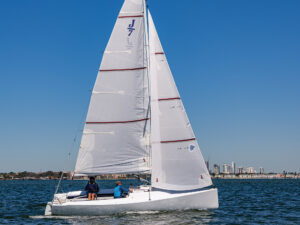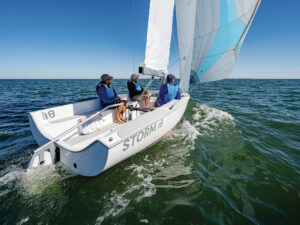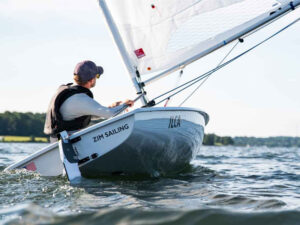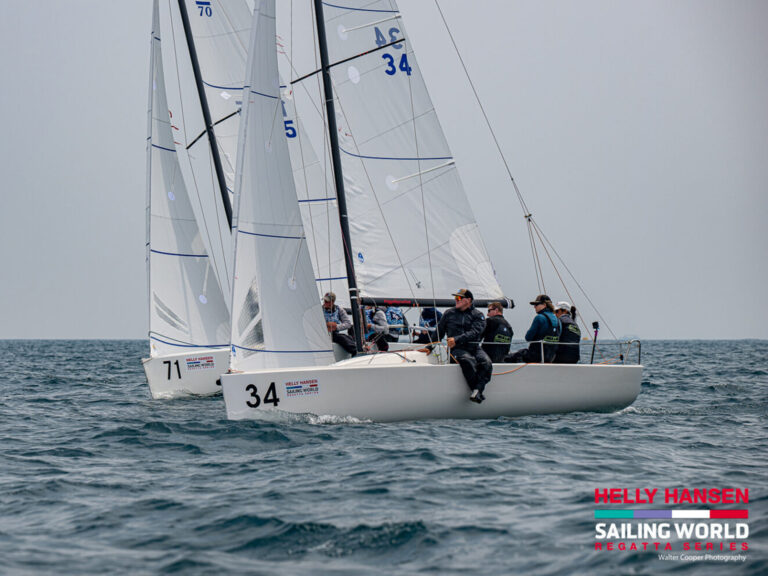
BOTYesseSt
In the world of yacht racing, aesthetics took a back seat to design a long time ago. As a result, there are few boats out there today that make people stop and stare. But at the United States Sailboat Show this year there were a few boats that drew our attention. One in particular was the Esse 850, a 28-foot sportboat that’s not only drop-dead gorgeous, but a thrill to sail as well.The Esse, designed by Umberto Felci and built by J. Schucter Yachting, is first and foremost a gentleman’s performance daysailer. It’s a legs-in one-design with a narrow 7’6″ beam and a keel bulb that far outweighs the hull. “At first glance, the boat looks incapable of supporting its large sail plan,” says BOTY judge Meade Gougeon. “The reality is that it’s a 2,500-pound boat with 1,500 pounds of that weight six feet below the waterline. As a result, it’s surprisingly stiff.” The Esse’s stiffness was borne out in our test sail, which took place in puffy, 10-knot conditions. We were impressed with its performance, how easy it was to rig and sail, and how much fun we had sailing it. Upwind, it locked into a groove, and steering the well-balanced boat required only a fingertip grip. The underdeck-mounted headsail furler adds to the ease of shorthanded sailing and brings the foot of the sail close to deck level, which no doubt helps the boat’s impressive upwind performance.Once we had the 860-square-foot gennaker flying, the boat really came to life. “The helm is well balanced,” says Andrews. “Put it on a tight reach and the foot of the spinnaker will drag in the water quite a while before the rudder stalls. The boat turns well and jibes easily, which is not always the case for sprit boats. It’s really easy to get the timing right so that you come out of the jibes with the kite popping full.”Even Gougeon, a self-proclaimed multihull fanatic embraced the Esse. “It’s a ballasted monohull sportboat that I can actually get excited about because of its unusual off-the-wind potential,” he says.To only tout its performance on the water would neglect the Esse’s full package. The boat was introduced in Europe in 2004, so the model we sailed in Annapolis is the result of two years of refinement. “This is a polished package where all the parts seem to work well,” says BOTY judge Alan Andrews. “Details such as the notch in the cockpit seat, which holds the ball end of the tiller extension and locks the tiller in the center of the boat for a quick, short-handed kite hoist or dowse, is an example.”The Esse’s construction isn’t all that high-tech; it’s built with epoxy, foam core, and E-glass in Italy, then finished by Schucter in Switzerland. The quality of the construction is outstanding, as one can see down below. The Esse’s interior, while minimal, is elegant and finished nicely. There’s a platform forward that, once cushioned, will work well as a V-berth, and there’s room for sail and gear stowage as well as a port-a-potty.On deck, the Esse is all about ergonomics, style, and details. All control lines lead aft under or on the low, sleek deckhouse. The mainsheet and traveler are forward of the tiller, and the cunningham, and backstay controls exit from a low box on centerline that also acts as a foot brace. All control-line tails disappear into the vertical faces of the cockpit seats through beveled stainless-steel plates, and bungee cords take up slack. The optional teak floor in the cockpit looks good and feels great underfoot. The Esse we sailed came with a 2-horsepower outboard, which mounts on a removable stern bracket, and is stowed low in the boat in a cavernous centerline storage area under a hatch in the cockpit floor. There’s an option for a diesel/saildrive power package (the boat comes standard with the engine footings built into the hull), but all judges felt the outboard did the job well, and liked the idea of keeping the boat simple.The rig is aluminum, as is the boom. “It works well,” says Andrews. “The easy-to-adjust backstay and natural twisting ability of the square-top main combine to rapidly power up and depower the rig in the gusty conditions.” The rig is deck-stepped, with a compression tube below. The spinnaker pole, which exits on the starboard side of the bow, is carbon, and the sprit pole casing, which is watertight, drains out the topsides via a flush exit.BOTY judge Chuck Allen’s paean to the boat is the one that resonates best. Allen, a former All-American who’s also spent a lot of time racing small keelboats, sums up the Esse succinctly, and explains why the judges chose it as their overall winner. “The Esse 850 is one of the best sportboats I’ve ever sailed,” says Allen. “It’s quite simple, it’ll be easy to singlehand, and it’s easy on the eyes. This is the perfect boat to sail in your Tuesday night series or a venue like Key West Race Week.”









